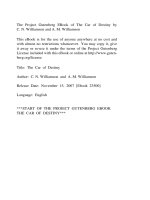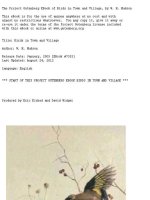The Project Gutenberg EBook of Darwin, and After Darwin (Vol. 1 and 3, of 3), by George John docx
Bạn đang xem bản rút gọn của tài liệu. Xem và tải ngay bản đầy đủ của tài liệu tại đây (8.3 MB, 1,156 trang )
The Project Gutenberg EBook of Darwin, and
After Darwin (Vol. 1 and 3, of
3), by George John Romanes
This eBook is for the use of anyone
anywhere at no cost and with
almost no restrictions whatsoever. You may
copy it, give it away or
re-use it under the terms of the Project
Gutenberg License included
with this eBook or online at
www.gutenberg.org
Title: Darwin, and After Darwin (Vol. 1
and 3, of 3)
An Exposition of the Darwinian Theory and
a Discussion of
Post-Darwinian Questions
Author: George John Romanes
Release Date: March 11, 2008 [EBook
#24800]
Language: English
*** START OF THIS PROJECT GUTENBERG EBOOK
DARWIN ***
Produced by Marilynda Fraser-Cunliffe, LN
Yaddanapudi and
the Online Distributed Proofreading Team
atDARWIN, AND
AFTER DARWIN
AN EXPOSITION OF
THE DARWINIAN
THEORY AND A
DISCUSSION OF
POST-DARWINIAN
QUESTIONS
BY
GEORGE JOHN
ROMANES, M.A.,
LL.D., F.R.S.
Honorary Fellow of Gonville and Caius
College, Cambridge
I
THE DARWINIAN
THEORY
FOURTH EDITION
Chicago
THE OPEN COURT PUBLISHING
COMPANY.
1910
The Illustrations of this book (with the
exception of the Frontispiece and the
colored plate facing page 332) are
copyrighted under the title “Darwinism
Illustrated.”
PRESS OF THE
BLAKELY-OSWALD PRINTING CO.
CHICAGO
Ch. Ch. Oxford:
March 15th 1892.
My dear Sir,
As we have now agreed that
the Open Court Publishing Company is to
undertake the American edition of my
work entitled “Darwin and after
Darwin,” I have much pleasure
in transferring to you the copyright
thereof, with all that this
includes.
Thanking you very much for
the kindness and liberality which
have marked your conduct of these
negotiations,
I remain,
Yours very faithfully,
George J. Romanes
To
Edward C. Hegeler Esq.
La Salle, Ill. U. S.
Several years ago Lord Rosebery
founded, in the University of Edinburgh, a
lectureship on “The Philosophy of Natural
History,” and I was invited by the Senatus
to deliver the lectures. This invitation I
accepted, and subsequently constituted the
material of my lectures the foundation of
another course, which was given in the
Royal Institution, under the title “Before
and after Darwin.” Here the course
extended over three years—namely from
1888 to 1890. The lectures for 1888 were
devoted to the history of biology from the
earliest recorded times till the publication
of the “Origin of Species” in 1859; the
lectures for 1889 dealt with the theory of
organic evolution up to the date of Mr.
Darwin’s death, in 1882; while those of
the third year discussed the further
developments of this theory from that date
till the close of the course in 1890.
It is from these two courses—which
resembled each other in comprising
between thirty and forty lectures, but
differed largely in other respects—that the
present treatise has grown. Seeing,
however, that it has Grown much beyond
the bulk of the original lectures, I have
thought it desirable to publish the whole in
the form of three separate works. Of these
the first—or that which deals with the
purely historical side of biological
science—may be allowed to stand over
for an indefinite time. The second is the
one which is now brought out and which,
as its sub-title signifies, is devoted to the
general theory of organic evolution as this
was left by the stupendous labours of
darwin. as soon as the translations shall
have been completed, the third portion
will follow (probably in the autumn
season), under the sub-title, “post-
darwinian questions.”
As the present volume is thus intended
to be merely a systematic exposition of
what may be termed the Darwinism of
Darwin, and as on this account it is likely
to prove of more service to general
readers than to professed naturalists, I
have been everywhere careful to avoid
assuming even the most elementary
knowledge of natural science on the part
of those to whom the exposition is
addressed. The case, however, will be
different as regards the next volume,
where I shall have to deal with the
important questions touching Heredity,
Utility, Isolation, &c., which have been
raised since the death of Mr. Darwin, and
which are now being debated with such
salutary vehemence by the best naturalists
of our time.
My obligations to the Senatus of the
University of Edinburgh, and to the Board
of Management of the Royal Institution,
have already been virtually expressed; but
I should like to take this opportunity of
also expressing my obligations to the
students who attended the lectures in the
University of Edinburgh. For alike in
respect of their large numbers, their keen
intelligence, and their generous sympathy,
the members of that voluntary class
yielded a degree of stimulating
encouragement, without which the labour
of preparing the original lectures could
not have been attended with the interest
and the satisfaction that I found in it. My
thanks are also due to Mr. R. E. Holding
for the painstaking manner in which he has
assisted me in executing most of the
original drawings with which this volume
is illustrated; and likewise to Messrs.
Macmillan and Co. for kindly allowing me
to reprint—without special
acknowledgment in every case—certain
passages from an essay which they
published for me many years ago, under
the title “Scientific Evidences of Organic
Evolution.” Lastly, I must mention that I
am indebted to the same firm for
permission to reproduce an excellent
portrait of Mr. Darwin, which constitutes
the frontispiece.
Christ Church, Oxford,
April 19th, 1892.
CONTENTS
PAGE
CHAPTER I.
Introductory 1
CHAPTER II.
Classification 23
CHAPTER III.
Morphology 50
CHAPTER IV.
Embryology 98
CHAPTER V.
Palæontology 156
CHAPTER VI.
Geographical Distribution 204
CHAPTER VII.
The Theory of Natural Selection 251
CHAPTER VIII.
Evidences of the Theory of
Natural Selection
285
CHAPTER IX.
Criticisms of the Theory of
Natural Selection
333
CHAPTER X.
The Theory of Sexual Selection,
and Concluding Remarks
379
Appendix to Chapter V. 421
Note A to Page 257 443
Note B to Page 295 445
Note C to Page 394 448
Index 451
LIST OF
ILLUSTRATIONS
Fig. page
1. Successive forms of Paludina, from
the Tertiary deposits of Slavonia
19
2. Skeleton of Seal 52
3. Skeleton of Greenland Whale 53
4. Paddle of Whale compared with
Hand of Man
54
5. Wing of Reptile, Mammal, and Bird 56
6. Skeleton of Dinornis gravis 61
7. Hermit crabs compared with the
cocoa-nut crab
64
8. Rudimentary or vestigial hind-limbs
of Python
67
Apteryx Australis 69
10. Illustrations of the nictitating
membrane in various animals named
75
11. Rudimentary, or vestigial and
useless, muscles of the human ear
76
12. Portrait of a young male gorilla 78
13. Portrait of a young male child 79
14. An infant, three weeks old,
supporting its own weight
81
15. Sacrum of Gorilla compared with
that of Man, showing the
rudimentary tail-bones of each
82
16. Diagrammatic outline of the human
embryo when about seven weeks
old
83
17. Front and back view of adult human
sacrum
84
18. Appendix vermiformis in Orang and
in Man
85
19. The same, showing variation in the
Orang
85
20. Human ear 86
21. Fœtus of an Orang 87
22. Vestigial characters of human ears 88
23. Hair-tracts on the arms and hands of
Man, as compared with those on the
arms and hands of Chimpanzee
90
24. Molar teeth of lower jaw in Gorilla,
Orang, and Man
93
25. Perforation of the humerus (supra-
condyloid foramen) in three species
of Quadrumana where it normally
occurs, and in Man, where it does
95
not normally occur
26. Antlers of stag, showing successive
addition of branches in successive
years
100
27. Fission of a Protozoön 107
28. Hydra viridis, partly in section 111
29. Successive stages in the division of
the ovum, or egg-cell, of a worm
113
30. Ovarian ovum of a Mammal 121
31. Amœboid movements of young egg-
cells
122
32. Human ovum, mature and greatly
magnified
123
33. Stages in the formation of the polar
bodies in the ovum of a star-fish
125
34. Fertilization of the ovum of an
echinoderm
126
35. Fertilization of the ovum of a star-
fish
127
36. Karyokinesis of a typical tissue-cell
(epithelium of Salamander)
129
37. Study of successive changes taking
place in the nucleus of an
epithelium-cell, preparatory to
division of the cell
131
38. Formation and conjugation of the
pronuclei in Ascaris megalocephala
132,
133
39. Segmentation of ovum 135
40. The contents of an ovum in an
advanced stage of segmentation,
drawn in perspective
135
41. Formation of the gastrula of
Amphioxus
137
42. Gastrulation 138
43. Gastrula of a Chalk Sponge 139









